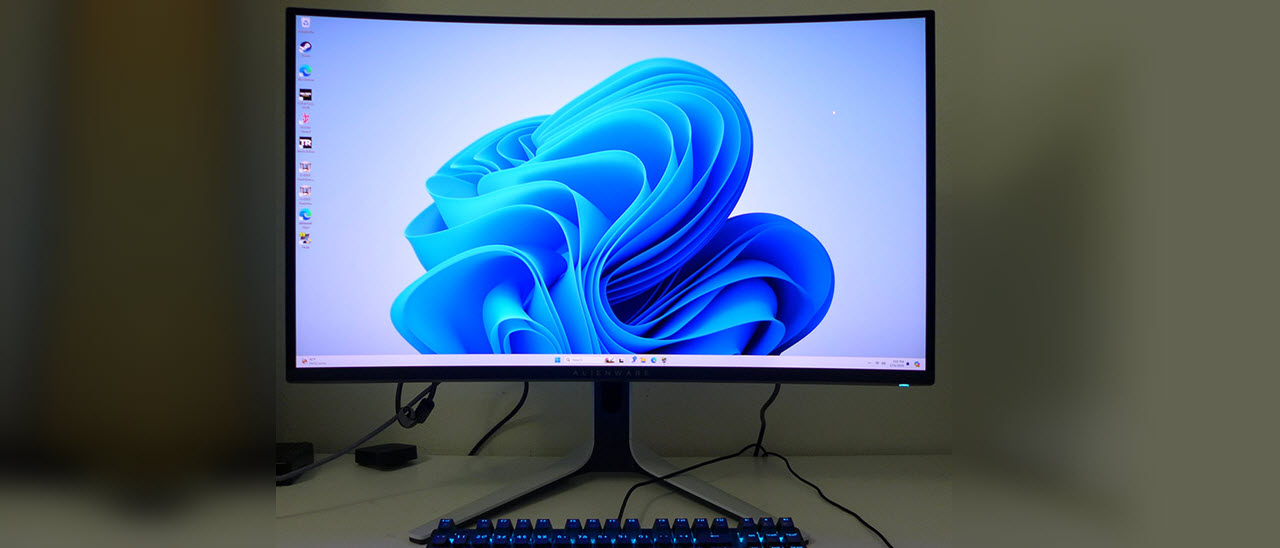Why you can trust Tom's Hardware
Insert heading
The AW3225QF ships in its Standard picture mode which is accurate enough to be used without calibration. It uses the full native color gamut, which covers 109% of DCI-P3, for all SDR content. If you want sRGB, it is available in the Creator mode.
Grayscale and Gamma Tracking
Our grayscale and gamma tests use Calman calibration software from Portrait Displays. We describe our grayscale and gamma tests in detail here.
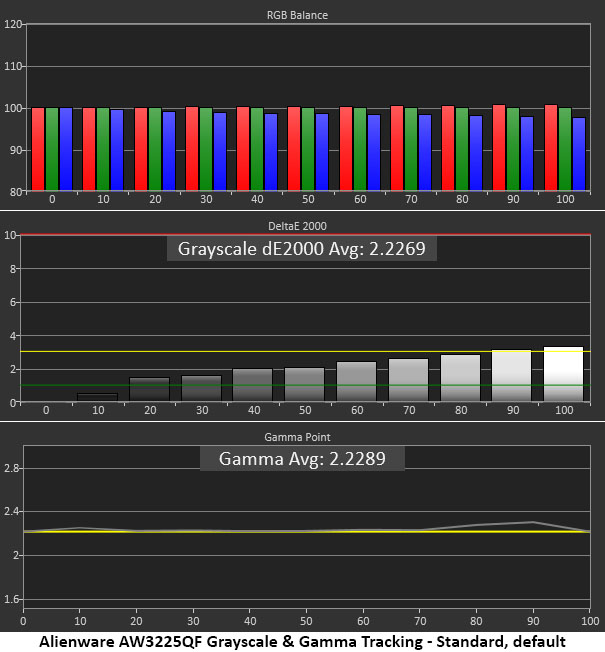
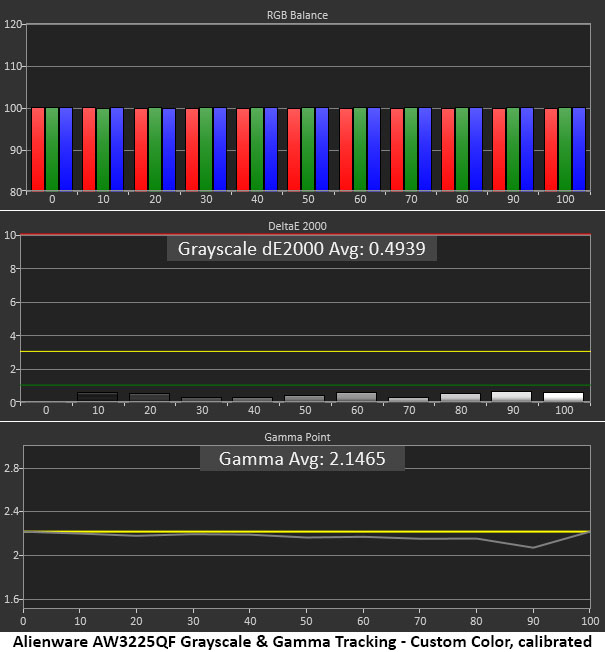

Out of the box, the AW3225QF puts up a solid grayscale and gamma chart. There are no visible grayscale errors and gamma is nearly all on the 2.2 reference line. There is a slight hump at 80 and 90%, which represents lower output values, but you’ll have a hard time seeing this in actual content. This is excellent performance.
In Custom Color mode, you get RGB gain and bias sliders that are very precise. I only adjusted the gains to achieve pro-level numbers. Gamma went a tad light with a dip at 90%, but again, this is hard to spot in actual content.
The sRGB option in Creator mode has excellent grayscale tracking, but gamma is a little wonky. The 10% step is too light, making shadow detail more visible but less impactful. The range between 30 and 80% is a tad dark, but that is forgivable given the AW3225QF’s high contrast. You can compensate by turning up the brightness a click or two.
Comparisons
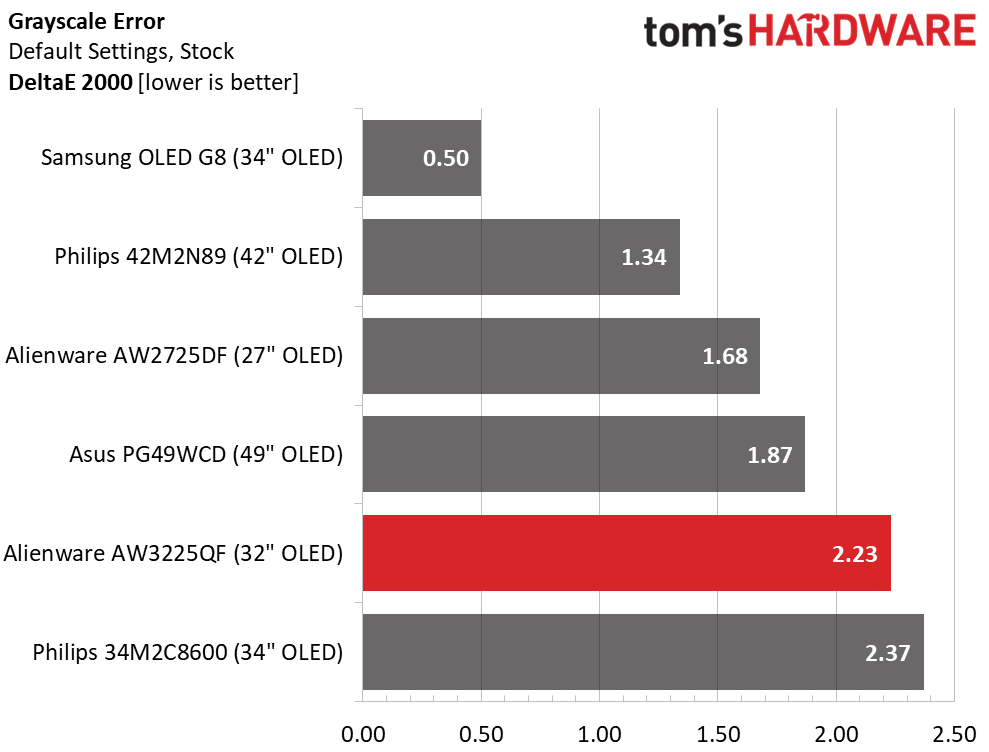
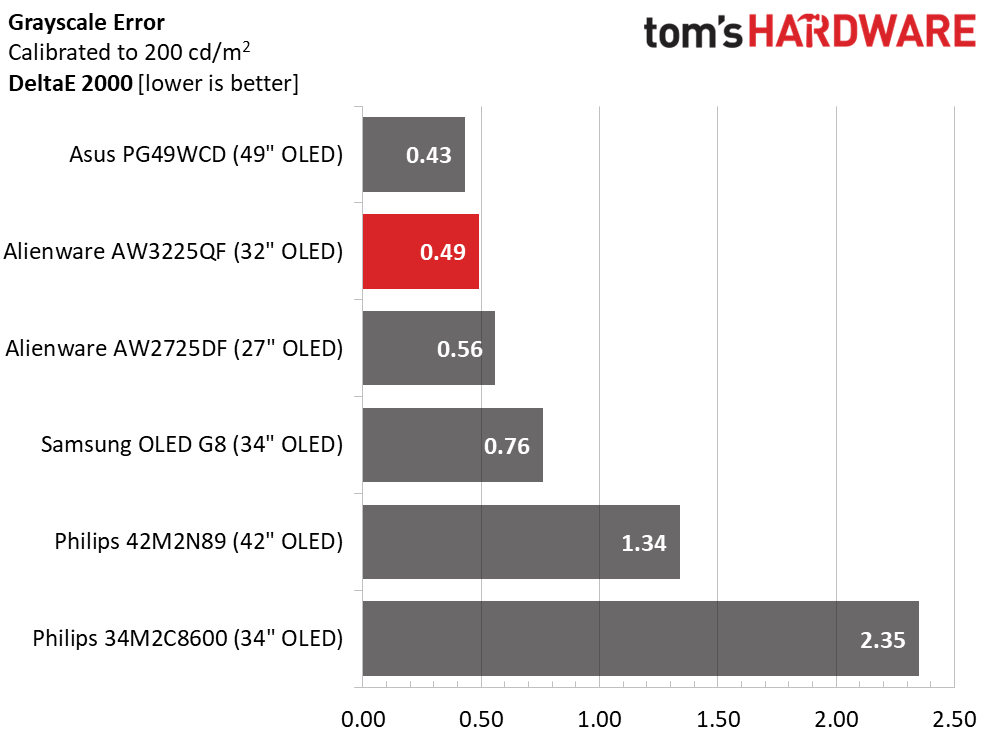
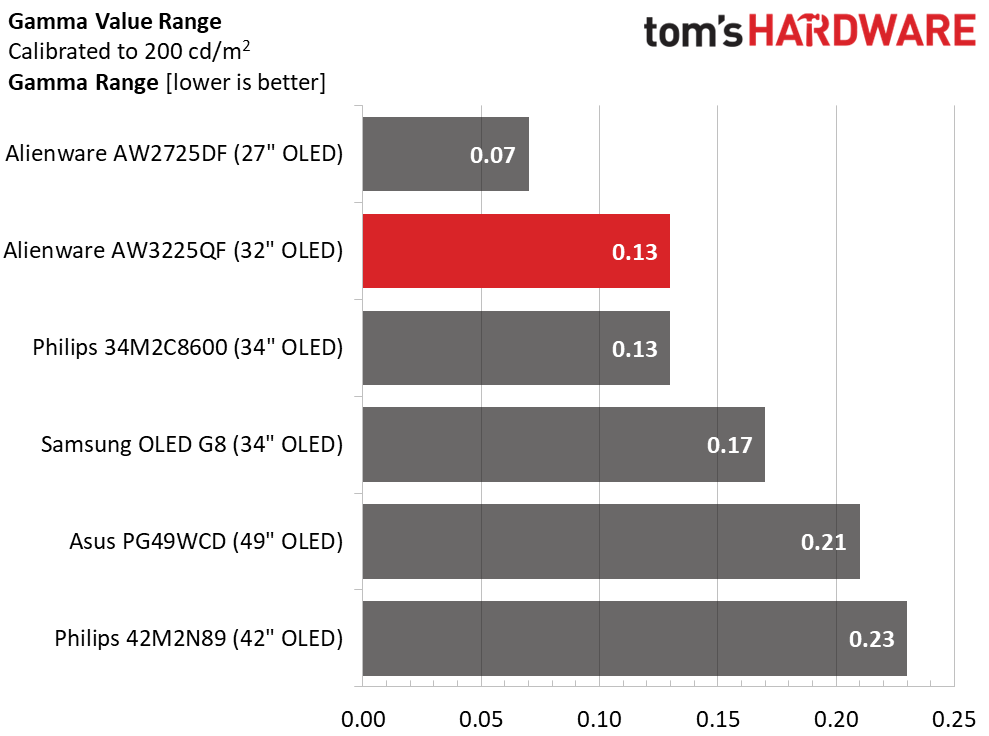

OLEDs in general have solid out-of-box accuracy in my observation. The AW3225QF is a bit behind the pack, but visually, it is the same as the top screens. The Samsung is a definite over-achiever with its 0.50dE default result.
After calibration, the AW3225QF improved to second place at 0.49dE. Obviously, the G8 should be left alone since its error level increased with calibration. But these are very fine and ultimately invisible differences. OLEDs are premium products, and as such, they deliver high accuracy and fidelity.
Get Tom's Hardware's best news and in-depth reviews, straight to your inbox.
In the gamma tests, the AW3225QF shows a tight range of values, but the dip at 90%, which I noted earlier, pulls its average further from 2.2. A 2.27% deviation equates to an actual value of 2.15, which is not bad but not as good as the others.
Color Gamut Accuracy
Our color gamut and volume testing use Portrait Displays’ Calman software. For details on our color gamut testing and volume calculations, click here.
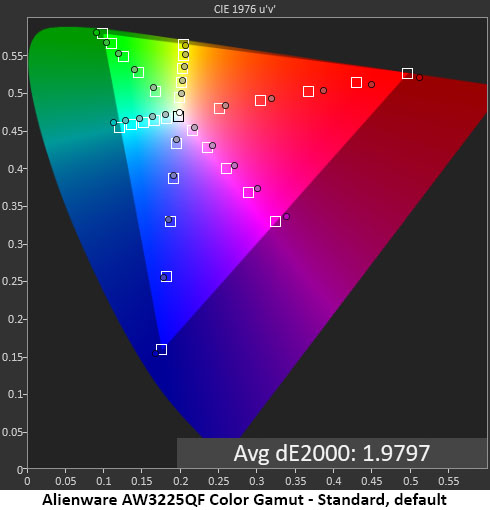

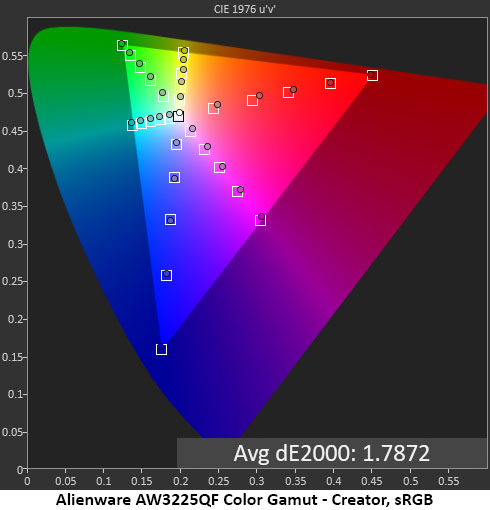
In the color gamut tests, the AW3225QF leaves no cause for complaint. In Standard mode, you can see that it goes past the triangle perimeter for all colors and is slightly over-saturated overall. Tracking is linear, which results in a very colorful and natural image. The errors are small enough to be invisible. Only slight hue issues remain in cyan and magenta.
My grayscale calibration fixes the secondary colors and leaves saturation points unchanged. The improvement is more measured than visible. No one will complain about an uncalibrated AW3225QF.
The Creator mode offers a spot-on sRGB option with a low error level of 1.79dE. This is professional grade accuracy. You can’t adjust grayscale in this mode but there are gamma presets that work well.
Comparisons
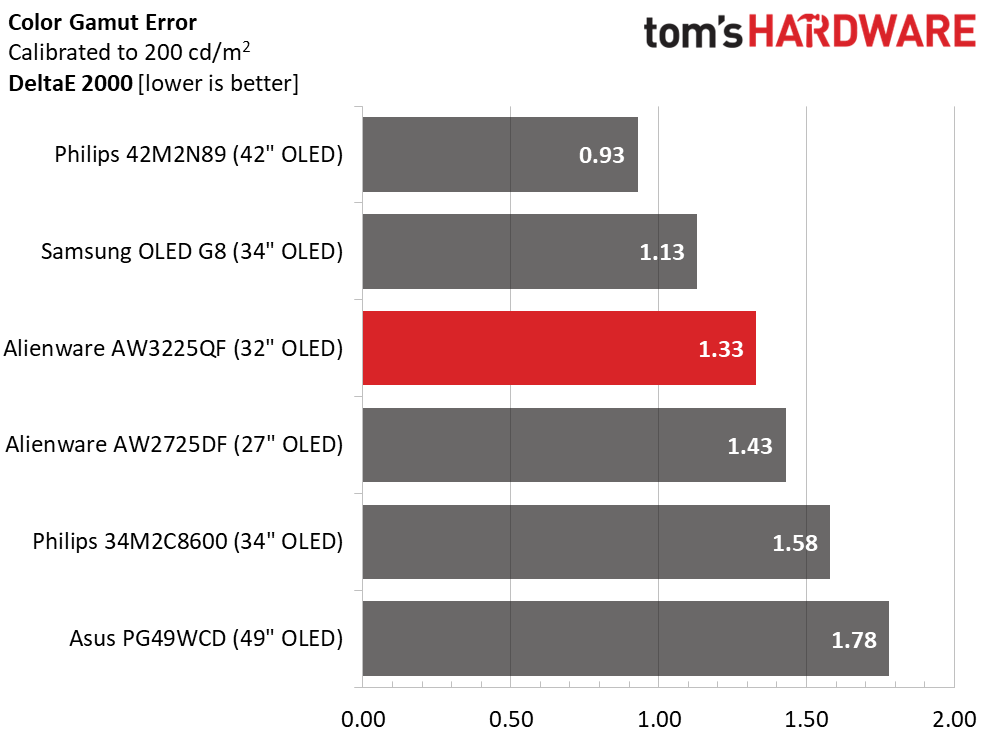
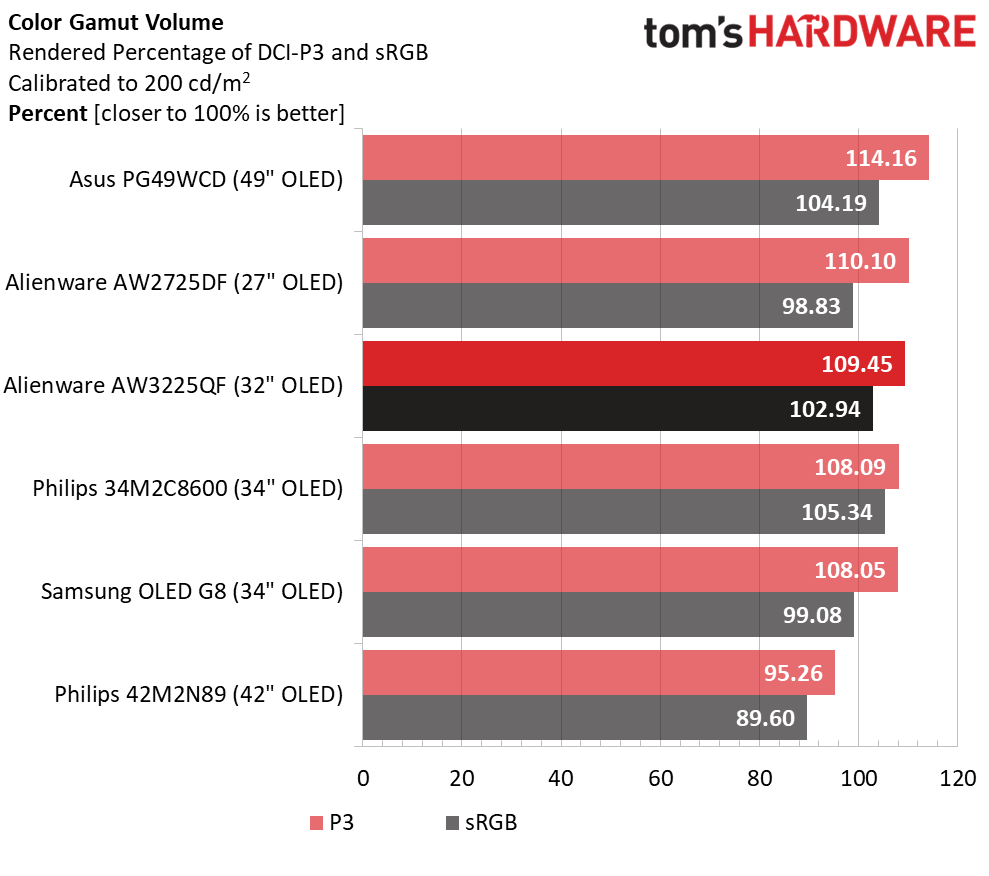
It doesn’t get much better than the AW3225QF’s 1.33dE color score unless you’re a 42M2N89 or an OLED G8. Those differences are visible to the color meter but not to the naked eye. You can choose any of these screens and enjoy excellent performance.
Besides its blinding speed, the AW3225QF’s biggest selling point is its large color gamut. It’s roughly equal to the AW2725DF and a few points shy of the current OLED record holder, Asus’ PG49WCD. With the lowest volume here being 95.26%, you won’t be unhappy with any of these monitors. However, the Quantum Dot technology has a clear advantage. Whether you use DCI-P3 or sRGB, the AW3225QF is qualified for color-critical applications.
Test Takeaway: You won’t find many monitors more colorful than the AW3225QF. Among OLEDs, only the PG49WCD has greater volume. That color is accurate right out of the box and can be made slightly better with calibration. There is nothing to complain about here. It won’t get better until Rec.2020 monitors are available to consumers.
MORE: Best Gaming Monitors
MORE: How We Test PC Monitors
MORE: How to Buy a PC Monitor
MORE: How to Choose the Best HDR Monitor
Current page: Grayscale, Gamma and Color
Prev Page Brightness and Contrast Next Page HDR Performance
Christian Eberle is a Contributing Editor for Tom's Hardware US. He's a veteran reviewer of A/V equipment, specializing in monitors. Christian began his obsession with tech when he built his first PC in 1991, a 286 running DOS 3.0 at a blazing 12MHz. In 2006, he undertook training from the Imaging Science Foundation in video calibration and testing and thus started a passion for precise imaging that persists to this day. He is also a professional musician with a degree from the New England Conservatory as a classical bassoonist which he used to good effect as a performer with the West Point Army Band from 1987 to 2013. He enjoys watching movies and listening to high-end audio in his custom-built home theater and can be seen riding trails near his home on a race-ready ICE VTX recumbent trike. Christian enjoys the endless summer in Florida where he lives with his wife and Chihuahua and plays with orchestras around the state.
-
cknobman Nice monitor just way too expensive.Reply
Crazy there is a market for $1200+ 32' monitors. -
AtonDude Not picking on the price per se, but this 'fun with specmanship' thing is SO blatantly funny. Peak 'effective' brightness limited to edges and spots but presented through marketing talking points as something so much more Grand - needs to stop - especially with the price-of-entry for these displays.Reply -
Dantte This is perfect and tics every box except I want this as a 32:9; kind of done with the multiple 16:9 monitors...Reply -
JTWrenn That price should really be in the cons. I get it's a great monitor and all but that price is crazy when you can buy a damn 65 inch oled tv at that price. I know it is apples and oranges....but you can still eat both of those fruits. It should be listed as a con, that is really expensive.Reply
edit: haha typed old instead of oled. Awesome typo, massively changed the meaning haha. -
dwd999 Reply
Be thankful that OLED prices are coming down. Its 40 percent of what LG's former OLED 32 inch monitor cost and about half of what I paid for their 27 inch model a couple of years ago. And now the refresh rates are 4 times higher. If you ever choose to use an OLED monitor with its true black background for an extended period of time you will understand why there's a market for $1200+ monitors.cknobman said:Nice monitor just way too expensive.
Crazy there is a market for $1200+ 32' monitors. -
8086 HDR10 should be a con. You may as well not even have or use the HDR on such a monitor as it's practically worthless. HDR400 or better please!Reply -
UnforcedERROR Reply
HDR10 is primarily a video format. HDR400 isn't even a format, it's a brightness specification, and the absolute lowest in that range as well. You got the concepts reversed, HDR400 is largely meaningless compared to HDR10, which has actual applications.8086 said:HDR10 should be a con. You may as well not even have or use the HDR on such a monitor as it's practically worthless. HDR400 or better please! -
oofdragon Just dumb, períod. 4k is 40+ inch resolution, $1200 is 40+ inch price. Just buy a TV, way better experience from a bigger screen l, better image quality and fair price for what you are payingReply -
Dantte Reply
40" maybe for a TV that you are sitting 8ft from, but when youre 2-3ft from the monitor, the 4K is extremely beneficial.oofdragon said:Just dumb, períod. 4k is 40+ inch resolution, $1200 is 40+ inch price. Just buy a TV, way better experience from a bigger screen l, better image quality and fair price for what you are paying
The pixel pitch of a 4k at 32" is 0.18mm. Industry (AV) accepted standard for minimum distance is 10ft for every 1mm of pitch, or in this case you would never want to be closer than 1.8ft from the screen or you could start seeing the individual pixels. Optimum is 2x that, or 3.6ft, this is sweet spot for a monitor of that size and resolution, and just happens to be how far most people sit away from their screens.
Compare that to the next resolution down, 1440p, and were talking 0.27mm, or minimum seating distance of 2.7ft which is roughly where most people are with there monitors. So 1440p is right on the edge, and the sweet spot is 5.4ft, which is much further away than most people view a monitor and is also beyond the "high detail" seating distance for a 32" monitor. This is why 1440p at 27" is generally referred to as perfect, and 1080p at 24" is right there too.
No, the standards dont change whe. new tech comes out, been this way for 2 decades, or thats how long ive been doing this. Its only been recently that the tech has caugh up with the human anatomy (eye). -
HyperMatrix Reply
Hate to be like this, but for this monitor I have to be. This monitor is a completely broken POS. Was listed as the worst of the 4K 240Hz QD OLED monitors by Hardware Unboxed. And has many fundamental flaws, resulting in a sub-par image compared to even Alienware’s previous 3440x1440 QD OLED.Admin said:Alienware’s AW3225QF ups the ante for QD-OLED desktop monitors with a 32-inch curved 4K panel that runs at 240 Hz with Adaptive-Sync, HDR10, Dolby Vision and wide gamut color.
Alienware AW3225QF OLED 4K gaming monitor review: Stunning speed, color and contrast : Read more
This monitor is garbage. And this glowing review leads me to believe the reviewer is…and I’m trying to be nice as I can here…but completely inexperienced when it comes to OLED/HDR and image adjustment.
This monitor should only be used in HDR1000 mode for gaming but reviewer says to use HDR 400. The monitor doesn’t allow color and contrast adjustments in HDR 1000 mode. It won’t let you use DLDSR or integer scaling because it won’t allow you to turn off DSC, which the ASUS and now MSI models do, and the Gigabyte model will soon. Also side note…if you have a TV hooked up to your PC, just having this monitor plugged in, not even on or being used, disables DLDSR on your TV as well.
Comparing the image on this to my AW3423DW is a night and day difference. The monitor suffers from raised blacks and less punchy image compared to its predecessor which is why I sent it back after a few weeks.
The OSD functionality is greatly limited with many features that existed on the AW3423DW now disabled. Such as the dark boost feature which won’t work in HDR anymore. The on screen crosshairs only give you 1 option and it’s not even a crosshairs. All the other monitors do a much better job.
The monitor is pure crap. And I’m frustrated over this terrible review of a terrible product. That you couldn’t find any cons is a reflection of your experience with what to look for and that. This was an advertisement. Not a review. Sorry not sorry. Worst 4K 240Hz QD OLED ever released.
p.s. link to a Reddit article documenting all the issues with the monitor. There have been a few firmware updates since then but none that resolved the main issues with the display.
https://www.reddit.com/r/OLED_Gaming/s/2oA2Xbz4LY
